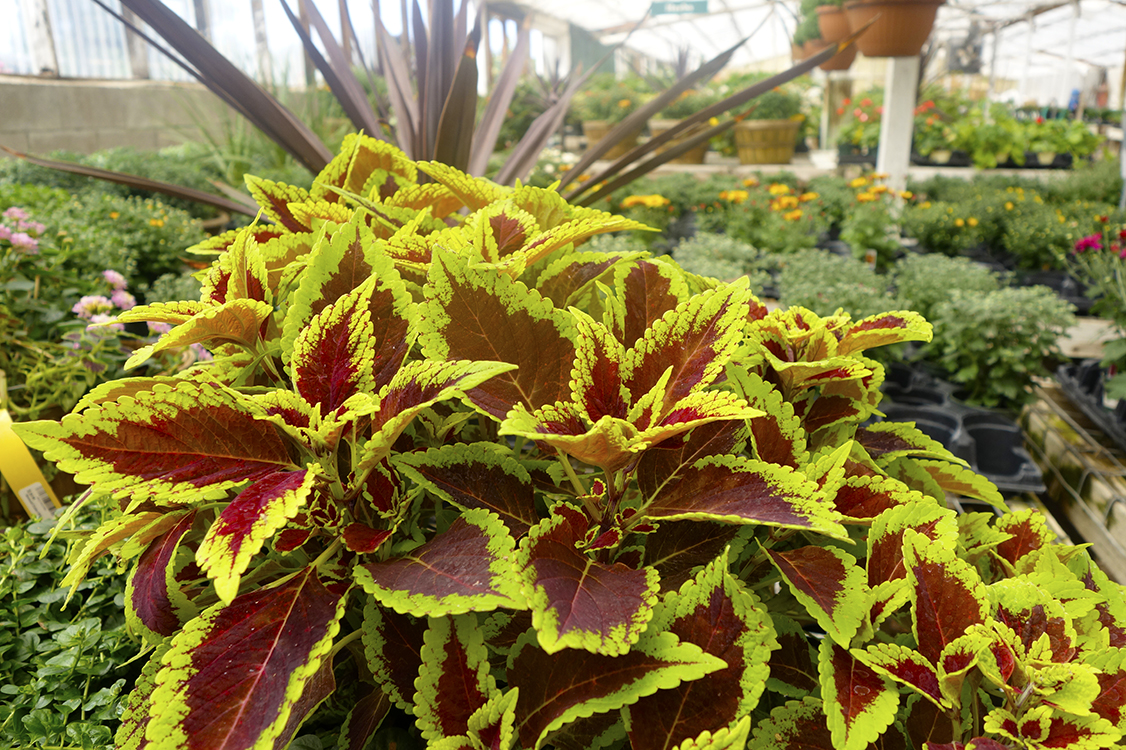By: The National Gardening Association
Photo: Payne’s Nurseries

Introduction to Coleus
If you’re looking for a plant with nonstop color, consider coleus. Grown for their ornamental foliage, coleus varieties offer an astonishing range of leaf sizes, shapes, colors, and patterning. This variety, along with the plants’ adaptability to shade and its easy-care nature, have helped coleus become a popular plant for containers and mixed plantings.
About Coleus
In its native habitat in southeast Asia, coleus is a perennial, and it can be grown as such in tropical and subtropical regions where temperatures remain above freezing. Elsewhere, this striking plant is usually grown as an annual to brighten and bring color to shade and part-shade gardens. Few plants can top coleus when it comes to versatility and variety. The allure of coleus lies in its foliage, and there is an incredible array of choices. Although the leaves of some coleus are a single color, most varieties boast multicolored foliage in hues of red, pink, orange, yellow, cream, chartreuse, green, burgundy, and/or dark purple. Some feature contrasting leaf margins or veins, while others are randomly blotched with color. Leaf size and shape also vary widely; some have broad, flat leaves, while others have elongated, lobed, scalloped, toothed, and/or ruffled foliage. Plant breeders continue to produce new varieties, including some that thrive in full sun.Unlike most plants that have colorful flowers adorning green foliage, the entire coleus plant is colorful. This allows you to arrange plants in dramatic blocks of bold color or creatively combine them with blooming annuals and perennials. One of their most popular uses is to brighten up shady spots where there are limited options for flowering plants.
Most of the coleus plants commonly available to home gardeners are Coleus scutellarioides (note that the scientific name has changed several times as botanists reclassify the plant so you may see it listed under different names). No matter what the name, coleus never fails to please. They’re members of the mint family, which hints at their ease of propagation: new plants can easily be grown from stem cuttings.
Growing Zones for Coleus
Coleus plants are hardy in USDA Hardiness Zones 10-11. In colder regions, the plant is grown as an annual. Some gardeners overwinter the plant indoors or root cuttings to grow through the winter for replanting in spring.
Choosing a Site to Grow Coleus
Coleus plants need well-drained soil that is rich in organic matter. Most varieties perform best in part shade where their vibrant colors really pop; full sun can bleach the foliage colors. Versatile and adaptable, coleus are well-suited to mixing in with perennials, planting in groups for dramatic drifts of color, or growing in containers to brighten porch, patio, deck, or entryway. Some newer varieties have been bred to thrive in full sun, though even these varieties will benefit from some afternoon shade. Indoors, give coleus plants bright light.
Planting Instructions for Coleus
Coleus can be grown from seed; however, the plants grow slowly at first. Sow seeds at least eight weeks before your average last frost date. Note that plants grown from seed will show some degree of variability. If you have your heart set on a certain look, it’s best to start with plants or rooted cuttings. Wait to plant coleus outdoors until temperatures are reliably above 60 degrees F. If planting in-ground, prepare the soil by loosening it to a depth of 8” and mix in some compost and/or slow-release fertilizer. Set the plants at the same depth as they’re growing in their containers, spacing them 12 to 24” apart depending on the mature size of the variety.
If planting in containers, choose a pot with drainage holes and fill it with potting mix amended with compost and/or slow-release fertilizer. For mixed plantings, choose companion plants with similar light and soil requirements.Pinch the growing tips at planting time to encourage branching.
Fertilizer for Coleus
Coleus are light feeders. If you amended the soil at planting time, plan to fertilize monthly with an all-purpose fertilizer. Container-grown plants benefit from twice-monthly feedings.
Coleus Pests and Problems
Coleus have few pest issues, especially when growing outdoors. Small pests, such as aphids, whiteflies, and spidermites, are occasionally troublesome, especially on indoor plants. Control them with insecticidal soap.
Ongoing Care for Coleus
Continue to pinch the plants’ growing tips to encourage branching. You can leave the flower spikes or prune them off as they appear to encourage the plant to put its energy into the foliage.
In frost-free climates the plants will grow year-round but will begin to get leggy after a few years. Plan to replace them with fresh plants every few years. Elsewhere, you can toss plants once they’ve been killed by frost or bring plants indoors for the winter. Or you can take cuttings from the plants in late summer to root and overwinter indoors.
